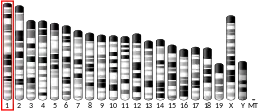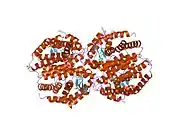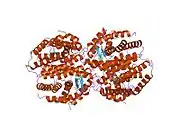The constitutive androstane receptor (CAR) also known as nuclear receptor subfamily 1, group I, member 3 is a protein that in humans is encoded by the NR1I3 gene.[5] CAR is a member of the nuclear receptor superfamily and along with pregnane X receptor (PXR) functions as a sensor of endobiotic and xenobiotic substances. In response, expression of proteins responsible for the metabolism and excretion of these substances is upregulated.[6] Hence, CAR and PXR play a major role in the detoxification of foreign substances such as drugs.
Androstenol and several isomers of androstanol, androstanes, are endogenous antagonists of the CAR, and despite acting as antagonists, were the basis for the naming of this receptor.[7] More recently, dehydroepiandrosterone (DHEA), also an androstane, has been found to be an endogenous agonist of the CAR.[8]
Function
CAR is a member of the nuclear receptor superfamily, and is a key regulator of xenobiotic and endobiotic metabolism. Unlike most nuclear receptors, this transcriptional regulator is constitutively active in the absence of ligand and is regulated by both agonists and inverse agonists. Ligand binding results in translocation of CAR from the cytosol into the nucleus, where the protein can bind to specific DNA sites, called response elements. Binding occurs both as a monomer and together with the retinoid X receptor (RXR) resulting in activation or repression of target gene transcription. CAR-regulated genes are involved in drug metabolism and bilirubin clearance. Examples for CAR-regulated genes are members of the CYP2B, CYP2C, and CYP3A subfamilies, sulfotransferases, and glutathione-S-transferases.[9] Ligands binding to CAR include bilirubin, a variety of foreign compounds, steroid hormones, and prescription drugs.[10]
Activation mechanism
Phosphorylated CAR forms a multiprotein complex with the heat shock protein 90 (hsp90) and the cytoplasmic CAR retention protein (CCRP) which keep CAR in the cytosol thereby inactivating it.[11] CAR can be activated in two ways: by direct binding of a ligand (e.g. TCPOBOP) or indirect regulation by phenobarbital (PB), a common seizure medication, facilitating the dephosphorylation of CAR through protein phosphatase 2 (PP2A) (Fig. 1).[12]
Both lead to the release of CAR from the multiprotein complex and its translocation into the nucleus. Here, CAR forms a heterodimer with retinoid X receptor (RXR) and interacts with the phenobarbital-responsive enhancer module (PBREM), a distal enhancer activating transcription of CAR target genes.[13]
The consensus sequence of PBREM, containing direct repeat-4 motifs, was found to be conserved in mouse, rat and human 'Cyp2b' genes.[14][15][16]
Direct activation
1,4-bis[2-(3,5-dichloropyridyloxy)]benzene (TCPOBOP) is thought to bind directly to mouse CAR, thus inducing its translocation into the nucleus.[17] TCPOBOP does not bind to human CAR and hence has no effect on it. Human CAR can be activated by CITCO (6-(4-chlorophenyl)imidazo(2,1-b)(1,3)thiazole-5-carbaldehyde O-(3,4-dichlorobenzyl)oxime).[18]
Indirect activation

Phenobarbital (PB), a widely used anticonvulsant, is used as a model ligand for indirect CAR activation. PB activates CAR, by inducing the dephosphorylation of CAR through PP2A. How PP2A is activated remains unclear, but several different mechanisms have been proposed.[19][20] The recruitment of PP2A has been shown to be mediated by the multiprotein complex. As PB is involved in the activation of AMP-activated protein kinase, it has been suggested that AMPK activates PP2A.[21]
Alternatively, PP2A might be activated through another pathway including the epidermal growth factor receptor (EGFR) and the receptor for activated C kinase 1 (RACK1). In the absence of PB, the epidermal growth factor (EGF) binds to EGFR, thereby activating the steroid receptor coactivator-1 (Src1), which in turn phosphorylates RACK1. Upon PB-exposure, PB binds competitively to EGFR and thus leads to inactivation of Src1. This results in a dephosphorylation of RACK1, which can subsequently stimulate PP2A to activate CAR.[20]
References
- 1 2 3 GRCh38: Ensembl release 89: ENSG00000143257 - Ensembl, May 2017
- 1 2 3 GRCm38: Ensembl release 89: ENSMUSG00000005677 - Ensembl, May 2017
- ↑ "Human PubMed Reference:". National Center for Biotechnology Information, U.S. National Library of Medicine.
- ↑ "Mouse PubMed Reference:". National Center for Biotechnology Information, U.S. National Library of Medicine.
- ↑ Baes M, Gulick T, Choi HS, Martinoli MG, Simha D, Moore DD (Mar 1994). "A new orphan member of the nuclear hormone receptor superfamily that interacts with a subset of retinoic acid response elements". Molecular and Cellular Biology. 14 (3): 1544–52. doi:10.1128/mcb.14.3.1544. PMC 358513. PMID 8114692.
- ↑ Wada T, Gao J, Xie W (Aug 2009). "PXR and CAR in energy metabolism". Trends in Endocrinology and Metabolism. 20 (6): 273–9. doi:10.1016/j.tem.2009.03.003. PMID 19595610. S2CID 25764831.
- ↑ Nicholas A. Meanwell (8 December 2014). Tactics in Contemporary Drug Design. Springer. pp. 182–. ISBN 978-3-642-55041-6.
- ↑ Kohalmy K, Tamási V, Kóbori L, Sárváry E, Pascussi JM, Porrogi P, Rozman D, Prough RA, Meyer UA, Monostory K (2007). "Dehydroepiandrosterone induces human CYP2B6 through the constitutive androstane receptor". Drug Metab. Dispos. 35 (9): 1495–501. doi:10.1124/dmd.107.016303. PMC 2423426. PMID 17591676.
- ↑ Ueda A, Hamadeh HK, Webb HK, Yamamoto Y, Sueyoshi T, Afshari CA, Lehmann JM, Negishi M (Jan 2002). "Diverse roles of the nuclear orphan receptor CAR in regulating hepatic genes in response to phenobarbital". Molecular Pharmacology. 61 (1): 1–6. doi:10.1124/mol.61.1.1. PMID 11752199. S2CID 20184152.
- ↑ "Entrez Gene: NR1I3 nuclear receptor subfamily 1, group I, member 3".
- ↑ Kodama S, Negishi M (2006). "Phenobarbital confers its diverse effects by activating the orphan nuclear receptor car". Drug Metabolism Reviews. 38 (1–2): 75–87. doi:10.1080/03602530600569851. PMID 16684649. S2CID 43824300.
- ↑ Men, Shuaiqian; Wang, Hongbing (2023). "Phenobarbital in Nuclear Receptor Activation: An Update". Drug Metabolism and Disposition. 51 (2): 210–218. doi:10.1124/dmd.122.000859. ISSN 0090-9556. PMC 9900862. PMID 36351837.
- ↑ Kawamoto T, Sueyoshi T, Zelko I, Moore R, Washburn K, Negishi M (Sep 1999). "Phenobarbital-responsive nuclear translocation of the receptor CAR in induction of the CYP2B gene". Molecular and Cellular Biology. 19 (9): 6318–22. doi:10.1128/mcb.19.9.6318. PMC 84602. PMID 10454578.
- ↑ Honkakoski P, Moore R, Washburn KA, Negishi M (Apr 1998). "Activation by diverse xenochemicals of the 51-base pair phenobarbital-responsive enhancer module in the CYP2B10 gene". Molecular Pharmacology. 53 (4): 597–601. doi:10.1124/mol.53.4.597. PMID 9547348. S2CID 38390000.
- ↑ Sueyoshi T, Kawamoto T, Zelko I, Honkakoski P, Negishi M (Mar 1999). "The repressed nuclear receptor CAR responds to phenobarbital in activating the human CYP2B6 gene". The Journal of Biological Chemistry. 274 (10): 6043–6. doi:10.1074/jbc.274.10.6043. PMID 10037683.
- ↑ Mäkinen J, Frank C, Jyrkkärinne J, Gynther J, Carlberg C, Honkakoski P (Aug 2002). "Modulation of mouse and human phenobarbital-responsive enhancer module by nuclear receptors". Molecular Pharmacology. 62 (2): 366–78. doi:10.1124/mol.62.2.366. PMID 12130690.
- ↑ Tzameli I, Pissios P, Schuetz EG, Moore DD (May 2000). "The xenobiotic compound 1,4-bis[2-(3,5-dichloropyridyloxy)]benzene is an agonist ligand for the nuclear receptor CAR". Molecular and Cellular Biology. 20 (9): 2951–8. doi:10.1128/MCB.20.9.2951-2958.2000. PMC 85552. PMID 10757780.
- ↑ Maglich JM, Parks DJ, Moore LB, Collins JL, Goodwin B, Billin AN, Stoltz CA, Kliewer SA, Lambert MH, Willson TM, Moore JT (May 2003). "Identification of a novel human constitutive androstane receptor (CAR) agonist and its use in the identification of CAR target genes". The Journal of Biological Chemistry. 278 (19): 17277–83. doi:10.1074/jbc.M300138200. PMID 12611900.
- ↑ Yoshinari K, Kobayashi K, Moore R, Kawamoto T, Negishi M (Jul 2003). "Identification of the nuclear receptor CAR:HSP90 complex in mouse liver and recruitment of protein phosphatase 2A in response to phenobarbital". FEBS Letters. 548 (1–3): 17–20. doi:10.1016/s0014-5793(03)00720-8. PMID 12885400. S2CID 24859426.
- 1 2 Mutoh S, Sobhany M, Moore R, Perera L, Pedersen L, Sueyoshi T, Negishi M (May 2013). "Phenobarbital indirectly activates the constitutive active androstane receptor (CAR) by inhibition of epidermal growth factor receptor signaling". Science Signaling. 6 (274): ra31. doi:10.1126/scisignal.2003705. PMC 5573139. PMID 23652203.
- ↑ Rencurel F, Stenhouse A, Hawley SA, Friedberg T, Hardie DG, Sutherland C, Wolf CR (Feb 2005). "AMP-activated protein kinase mediates phenobarbital induction of CYP2B gene expression in hepatocytes and a newly derived human hepatoma cell line". The Journal of Biological Chemistry. 280 (6): 4367–73. doi:10.1074/jbc.M412711200. PMID 15572372.
Further reading
- Masuno M, Shimozawa N, Suzuki Y, Kondo N, Orii T, Tsukamoto T, Osumi T, Fujiki Y, Imaizumi K, Kuroki Y (Mar 1994). "Assignment of the human peroxisome assembly factor-1 gene (PXMP3) responsible for Zellweger syndrome to chromosome 8q21.1 by fluorescence in situ hybridization". Genomics. 20 (1): 141–2. doi:10.1006/geno.1994.1144. PMID 8020947.
- Choi HS, Seol W, Moore DD (Jan 1996). "A component of the 26S proteasome binds on orphan member of the nuclear hormone receptor superfamily". The Journal of Steroid Biochemistry and Molecular Biology. 56 (1-6 Spec No): 23–30. doi:10.1016/0960-0760(95)00220-0. PMID 8603043. S2CID 46464350.
- Seol W, Choi HS, Moore DD (May 1996). "An orphan nuclear hormone receptor that lacks a DNA binding domain and heterodimerizes with other receptors". Science. 272 (5266): 1336–9. Bibcode:1996Sci...272.1336S. doi:10.1126/science.272.5266.1336. PMID 8650544. S2CID 32853062.
- Choi HS, Chung M, Tzameli I, Simha D, Lee YK, Seol W, Moore DD (Sep 1997). "Differential transactivation by two isoforms of the orphan nuclear hormone receptor CAR". The Journal of Biological Chemistry. 272 (38): 23565–71. doi:10.1074/jbc.272.38.23565. PMID 9295294.
- Seol W, Hanstein B, Brown M, Moore DD (Oct 1998). "Inhibition of estrogen receptor action by the orphan receptor SHP (short heterodimer partner)". Molecular Endocrinology. 12 (10): 1551–7. doi:10.1210/mend.12.10.0184. PMID 9773978.
- Forman BM, Tzameli I, Choi HS, Chen J, Simha D, Seol W, Evans RM, Moore DD (Oct 1998). "Androstane metabolites bind to and deactivate the nuclear receptor CAR-beta". Nature. 395 (6702): 612–5. Bibcode:1998Natur.395..612F. doi:10.1038/26996. PMID 9783588. S2CID 4387623.
- Gonzalez MM, Carlberg C (May 2002). "Cross-repression, a functional consequence of the physical interaction of non-liganded nuclear receptors and POU domain transcription factors". The Journal of Biological Chemistry. 277 (21): 18501–9. doi:10.1074/jbc.M200205200. PMID 11891224.
- Min G, Kim H, Bae Y, Petz L, Kemper JK (Sep 2002). "Inhibitory cross-talk between estrogen receptor (ER) and constitutively activated androstane receptor (CAR). CAR inhibits ER-mediated signaling pathway by squelching p160 coactivators". The Journal of Biological Chemistry. 277 (37): 34626–33. doi:10.1074/jbc.M205239200. PMID 12114525.
- Goodwin B, Hodgson E, D'Costa DJ, Robertson GR, Liddle C (Aug 2002). "Transcriptional regulation of the human CYP3A4 gene by the constitutive androstane receptor". Molecular Pharmacology. 62 (2): 359–65. doi:10.1124/mol.62.2.359. PMID 12130689.
- Ferguson SS, LeCluyse EL, Negishi M, Goldstein JA (Sep 2002). "Regulation of human CYP2C9 by the constitutive androstane receptor: discovery of a new distal binding site". Molecular Pharmacology. 62 (3): 737–46. doi:10.1124/mol.62.3.737. PMID 12181452. S2CID 25093374.
- Zhang J, Huang W, Chua SS, Wei P, Moore DD (Oct 2002). "Modulation of acetaminophen-induced hepatotoxicity by the xenobiotic receptor CAR". Science. 298 (5592): 422–4. doi:10.1126/science.1073502. PMID 12376703. S2CID 26269068.
- Chang TK, Bandiera SM, Chen J (Jan 2003). "Constitutive androstane receptor and pregnane X receptor gene expression in human liver: interindividual variability and correlation with CYP2B6 mRNA levels". Drug Metabolism and Disposition. 31 (1): 7–10. doi:10.1124/dmd.31.1.7. PMID 12485946. S2CID 42133087.
- Pascussi JM, Busson-Le Coniat M, Maurel P, Vilarem MJ (Jan 2003). "Transcriptional analysis of the orphan nuclear receptor constitutive androstane receptor (NR1I3) gene promoter: identification of a distal glucocorticoid response element". Molecular Endocrinology. 17 (1): 42–55. doi:10.1210/me.2002-0244. PMID 12511605.
- Shiraki T, Sakai N, Kanaya E, Jingami H (Mar 2003). "Activation of orphan nuclear constitutive androstane receptor requires subnuclear targeting by peroxisome proliferator-activated receptor gamma coactivator-1 alpha. A possible link between xenobiotic response and nutritional state". The Journal of Biological Chemistry. 278 (13): 11344–50. doi:10.1074/jbc.M212859200. PMID 12551939.
- Maglich JM, Parks DJ, Moore LB, Collins JL, Goodwin B, Billin AN, Stoltz CA, Kliewer SA, Lambert MH, Willson TM, Moore JT (May 2003). "Identification of a novel human constitutive androstane receptor (CAR) agonist and its use in the identification of CAR target genes". The Journal of Biological Chemistry. 278 (19): 17277–83. doi:10.1074/jbc.M300138200. PMID 12611900.
- Xie W, Yeuh MF, Radominska-Pandya A, Saini SP, Negishi Y, Bottroff BS, Cabrera GY, Tukey RH, Evans RM (Apr 2003). "Control of steroid, heme, and carcinogen metabolism by nuclear pregnane X receptor and constitutive androstane receptor". Proceedings of the National Academy of Sciences of the United States of America. 100 (7): 4150–5. Bibcode:2003PNAS..100.4150X. doi:10.1073/pnas.0438010100. PMC 153063. PMID 12644700.
- Huang W, Zhang J, Chua SS, Qatanani M, Han Y, Granata R, Moore DD (Apr 2003). "Induction of bilirubin clearance by the constitutive androstane receptor (CAR)". Proceedings of the National Academy of Sciences of the United States of America. 100 (7): 4156–61. Bibcode:2003PNAS..100.4156H. doi:10.1073/pnas.0630614100. PMC 153064. PMID 12644704.
- Auerbach SS, Ramsden R, Stoner MA, Verlinde C, Hassett C, Omiecinski CJ (Jun 2003). "Alternatively spliced isoforms of the human constitutive androstane receptor". Nucleic Acids Research. 31 (12): 3194–207. doi:10.1093/nar/gkg419. PMC 162252. PMID 12799447.
External links
- constitutive+androstane+receptor at the U.S. National Library of Medicine Medical Subject Headings (MeSH)
This article incorporates text from the United States National Library of Medicine, which is in the public domain.







